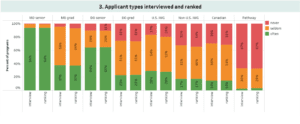MD vs. DO Programs: Which Path to Medicine is Right for You?

6644 Views
This blog was originally published in November 2021, and updated on March 7th, 2025 by Rebecca Lapides, MD Candidate.
When deciding to pursue a career in medicine, you’ll find that there are two main paths you can choose from: MD (allopathic) vs DO (osteopathic). Should you apply to an allopathic or an osteopathic medical school? What’s the difference between them, and which path is right for you?
With each year, the medical school application process becomes more and more competitive. While one might think that this competition is driven by an increased applicant pool and a limited number of program spots, this is actually not the case. Surprisingly, the choices of medical schools and thereby the number of program spots have been increasing right along with the competition. So how can this be?
The competition largely has to do with medical schools wanting to accept the most promising candidates that will drive high test scores and residency acceptance rates – an effective way to build the prestige of the school. The increase in institutions however has to do primarily with the rise of osteopathic (DO) medical schools. What exactly is a DO medical school? We’re glad you asked.
MD vs. DO: The Basics
The history of how traditional allopathic (MD) medical schools and osteopathic (DO) medical schools developed is long and complex. However, suffice it to say that allopathic programs, which bestow an MD degree upon completion, deliver the traditional Western style of evidence-based medicine developed in Europe during the period of the scientific revolution. The name “allopathic medicine” was actually coined as a derogatory term by the practitioners of homeopathic medicine, which today is widely considered a pseudoscience. Allopathic medicine follows from the historical transition from the work of Gaelen and Vessalius to Osler and Halsted and into the modern-day.
On the other hand, osteopathic medicine, which grants successful students the DO degree, derives from a tradition of muscle, bone (‘osteon’), and joint manipulation developed in the late 1800s by Dr. Andrew Still. The modern osteopathic school curriculum is nearly identical in content coverage to the modern allopathic school curriculum with the addition of the osteopathic manipulation curriculum that these programs teach.
Although the above summary can be helpful in understanding where these two strains of medical education come from, there are many questions that medical applicants ask us when trying to choose between DO medical school and MD medical school. Below we answer some of these questions.
Are there curriculum differences between Osteopathic medical schools and Allopathic medical schools?
As mentioned above, the two forms of medicine originally came from different historical lines of thought about disease and medical treatment. Over time, the curricula have become increasingly similar to the degree that they are almost indistinguishable from each other, except for one area.
In osteopathic medical schools, students spend 300-500 hours learning the theory and technique of osteopathic manipulation throughout their four-year degree. For many DO students, this manifests as an increased emphasis on anatomy, especially during the preclinical years. Studies of osteopathic manipulation suggest an indeterminate clinical benefit in the treatment of issues such as back pain. As such, there tends to be a reputation among DO schools that they emphasize a holistic, patient-centered approach to care, though many MD schools teach this approach as well.
Now is maybe a good time to mention that osteopathic manipulation is not to be confused with the field of chiropractic manipulation. In osteopathic medicine, there is no joint cracking nor any attempt at spinal realignment (which, in the cervical spine, has unfortunately been associated with vertebral artery dissection and fatal strokes).
The similarity of curricula between MD and DO medical schools is best reflected in the licensing exams that students take in order to obtain their medical license to practice and compete for residency positions. During medical school, MD students take the USMLE Step 1 and Step 2 exams, and the Step 3 exam during residency (usually at some point during their intern year). Likewise, DO students take the COMLEX Level 1 and Level 2 exams during medical school and Level 3 during residency. Many DO students also take one or more of the USMLE exams in addition to the COMLEX exams because it can help with improving one’s competitiveness in residency applications.
Do DO medical schools have the same admission requirements as MD schools?
Yes. Essentially there are no differences in the process of applying to an osteopathic (DO) medical school versus an allopathic (MD) medical school. The MCAT is generally a major factor in admissions decisions and the higher your score, the better your chances are of being accepted. Your undergraduate GPA, namely your science GPA, is also quite important.
Most differences in admissions requirements are particular to the medical school, for example, supplementary applications essays that focus on geographic or career interest (e.g. primary care or rural medicine oriented) factors. The principal difference between the applications is that MD medical school applicants must use the AMCAS application system (created by the AAMC) and DO medical school applicants must use the AACOMAS application system (created by the AACOM). Both applications evaluate an applicant’s undergraduate grades and coursework and both rely on the MCAT as a major factor in evaluating whom to invite for interviews and whom to offer admission. The only exception is that for students applying to an allopathic or osteopathic medical school in Texas, there is a separate application portal called the TMDSAS.
Note: If you are starting to notice that there seems to be a parallel set of organizations for MD and DO medical schools, you are correct!
Why are there so many new Osteopathic medical schools?
The reason that more new DO schools are being established than new MD schools is that the requirements for starting a new medical school in the US are less stringent for DO programs. To open and run an MD medical school in the US, the administration must receive recognition and accreditation from the AAMC’s Liaison Committee on Medical Education (LCME). Similarly, a DO medical school must receive accreditation from the American Osteopathic Association Commission on Osteopathic College Accreditation (COCA). The details of this accreditation process are complex and opaque.
One major difference between these two accreditation processes is that the LCME traditionally required (and still prefers) that an MD medical school be a non-profit institution, whereas the COCA does not impose this requirement. Therefore, many Osteopathic medical schools are for-profit and may be owned by individual investors or be a part of a larger corporate education system or media companies. However, this is not to say that all MD schools are non-profit. In particular, the numerous medical schools in the various Caribbean island countries are almost all for-profit, though they are allopathic medical schools.
Personal communication with several medical school founding deans also noted that MD schools are required to have a much higher level of institutional research funding, many times far greater than that required at a DO school. Thus, most of the MD schools in the US are affiliated with large state or private universities with heavy funding.
DO vs. MD: Why would someone choose DO over MD or MD over DO?
When choosing between pursuing an MD degree or a DO degree, applicants must consider several different factors. Below are some common considerations.
MCAT Scores and Undergraduate GPA – The first factor often considered when choosing between applying to MD or DO medical schools is GPA and MCAT scores. According to data from the AAMC and AACOM, osteopathic medical schools tend to accept applicants with lower GPAs and MCAT scores compared to their allopathic medical school counterparts. On average, those matriculating into a DO program in 2023 had a mean GPA and MCAT score of 3.53 and 503.6 respectively while those matriculating into an MD program had a mean GPA and MCAT score or 3.71 and 511.7. It is important to evaluate your own scores and academic performance to consider which type of program you may be the most competitive for.
Cost of Medical School Attendance – Perhaps surprisingly, the average cost to attend an allopathic medical school or an osteopathic medical school is very similar. According to the 2024-2025 AAMC Tuition and Fees Report, it costs an average of $54,323/year to go to an MD school while according to the 2023-2024 AACOM Report on Tuition, Fees, and Financial Aid, it costs an average of $55,130/year to go to a DO school. It is very important to note, however, that these averages include both in-state and out-of-state tuition as well as both private and public institutions. This means the averages can easily be +/- $10,000 (or much more!) for a given student at a given medical school. We highly suggest looking at both of the tuition summaries linked above to find more information about the cost of attending both MD and DO medical schools.
Average Salary – While DO vs. MD status does not directly impact earning potential in the way an MS vs. MBA degree could for a business person, MDs on average earn slightly more than DOs because of their increased tendency to pursue and be matched in highly competitive (and highly paid) medical specialties. According to Indeed Jobs, DOs in the United States earn an average of $163,908 per year while MDs earn an average of $201,918. Salary isn’t typically the deciding factor for choosing MD or DO, but for many students, it is worth noting.
Residency Program Acceptance Rates – While this may seem like a far-away consideration when only just applying to medical school, according to the 2020 NRMP Program Director Survey, DO residency applicants are at an overall disadvantage for program matching. While certain specialties are more friendly to DO applicants, only 64% of all surveyed program directors reported that they often interview senior DO applicants compared to 94% for MD seniors.
DO vs. MD: So, which degree is better?
All in all, which type of medical school is better for you to attend ultimately depends on YOU! In our experience, the deciding factor when considering DO vs. MD, and where to apply tends to be GPA and MCAT scores, while the deciding factor on where to actually attend tends to be cost, program offerings, and/or school prestige.
For most students, we recommend starting with the MSAR tool to make a big list of medical schools where your GPA and MCAT score are on par with those of students who have been recently accepted. From there, cost-conscious students should look at the AAMC and/or AACOM tuition report spreadsheets to narrow down which schools are within their budget or offer in-state tuition and financial aid support. Finally, do your research about each school left on your list and see if you can talk to a current student about their experience there. In the end, it’s all about finding your dream program that you get really excited about no matter whether it’s a DO or MD school!
We hope this post was helpful and wish everyone the best in their medical school applications!
Featured Articles

